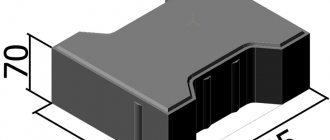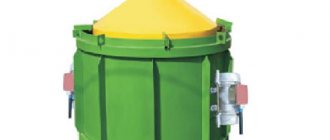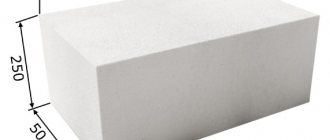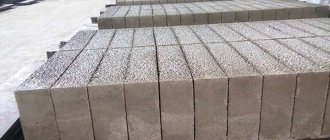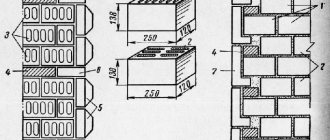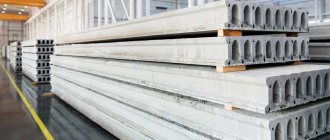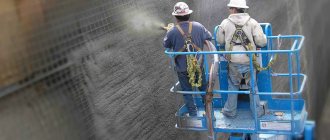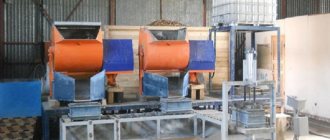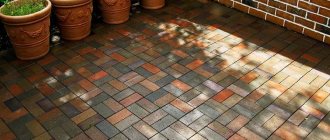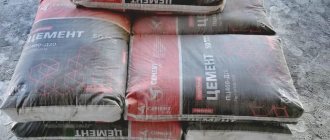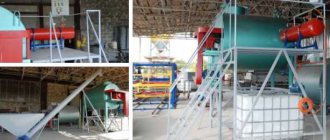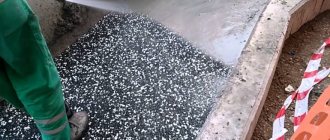Bakelite plywood is moisture resistant
| A special feature of this type of plywood is that it is impregnated with a special bakelite varnish during the production process, which makes it not just a moisture-resistant construction material, but highly water-resistant, plus good mechanical properties. Its main areas of application are difficult environmental conditions; it can be used in water for a long time. The weight of the sheet does not play such a significant role here. |
During production, adjacent layers of veneer are arranged in a mutually perpendicular orientation, which significantly increases mechanical strength. Bakelite varnish used in impregnation additionally has antiseptic properties, which virtually eliminates rotting and the formation of fungus and mold. It has high physical and mechanical properties and is used in shipbuilding, the automotive industry and construction. Bakelite plywood is most suitable for construction in difficult conditions and is especially resistant to environmental influences. It is resistant to various aggressive environments. Due to these special characteristics, it is used even in tropical climates and in sea water. This plywood is a birch veneer with a mutually perpendicular arrangement of fibers in adjacent layers. High strength allows this type of plywood to be used in the production of wear-resistant structures, for advertising billboards and production fences, and is irreplaceable as a housing material. It has high wear-resistant qualities and when used for formwork, the quality of the concrete surface remains good. The thermal conductivity of plywood allows you to stabilize the temperature in hot and cold weather, due to better compaction of concrete. The minimal need for subsequent treatment of concrete surfaces and the possibility of repeated use of formwork make it very profitable. The wide size of the sheets (5700×1250 mm, 2850×1250 mm) allows you to reduce the number of joints and fastenings. The possibility of production with the longitudinal direction of the fibers gives high strength to the formwork. To prevent exposure to moisture, the ends of the plywood are impregnated with waterproof bakelite varnish. If all rules of use are followed, the formwork can be used 100 or more times.
What is needed to produce building blocks?
It is known that cinder blocks were produced by reinforced concrete using special equipment using a steaming chamber. Therefore, the production of a high-quality block at home was not available.
But if there is demand, then supply is inevitable. And it is!
Since 1994, experience in the production of building blocks in private and small-scale production has provided the answer to the question posed.
Forms and equipment
equipped with high-tech modern equipment for the production of FBS blocks. In the process of manufacturing foundation blocks, we use industrial concrete mixers, which provide high quality mixtures, various shapes, and submersible deep vibrators.
Types of forms:
Regular.
Used for the manufacture of small batches of products. It is permissible to place blocks on the territory in different areas.
Vibroforms.
Used in the production of large batches, filled with a low-flow mixture. Lifting equipment is involved in the process. Product output is up to 40 blocks per shift in one vibration mold.
When working with rigid concrete, molding is provided once a day in a mold designed for one block. Material of normal mobility can be poured into molds of 2-4 blocks. When vibrators are installed in the mold, formwork is removed immediately after molding.
Our factory has modern cranes, with the help of which finished blocks of any type are moved to the warehouse and loaded into vehicles.
Equipment for self-production
It is not difficult to make your own equipment for preparing mortar and forming a hollow wall block at home. It is enough to have skills in working with a welding machine and an angle grinder, and be able to correctly calculate and cut metal.
The shape for the block is a regular rectangle with dimensions:
- Height 200 mm;
- Width 200 mm;
- Length 400 mm.
The mold is welded from a sheet of iron 4-5 mm thick. And it is reinforced from the outside with a frame made of a corner or profile pipe. For a brick press for the production of concrete hollow blocks, it is better to use replaceable elements to form internal voids:
- for load-bearing structures, round with a diameter of 100 mm;
- for internal walls, multi-profile elements made of square pipes;
- for partitions and semi-blocks, rectangular elements made of several profile pipes welded into one element.
A standard electric motor with an eccentric mounted on a shaft is used as a vibrator.
A self-assembled vibrating press driven by an electric motor must be safe from electric shock - the motor must be attached to the body through a rubber gasket, the handles must have rubber protective elements, and the cable used must have double insulation of the current-carrying conductors.
Main types of bakelite plywood
The difference between FBS and FBV
Since 2014, Russia has not produced bakelite plywood according to GOST, in which all layers are impregnated with bakelite resin.
Only 2 outer layers are impregnated with bakelite resin, and the inner layers are impregnated with other components, depending on the marking. To describe it briefly and in simple language, the main difference between FBS and FBV is as follows:
- FBS - the outer layers are impregnated with bakelite resins, and the inner layers are impregnated with phenol-formaldehyde resin.
- FBV - the outer layers are impregnated with bakelite resins, and the inner layers are impregnated with alcohol-soluble resins. Due to the absence of formaldehyde, it can be used in residential areas
All impregnation is carried out during the production process, sequentially - layer by layer of veneer, and not the finished sheet is dipped in resin. Only this technology provides guaranteed moisture resistance and very high strength and hardness of such plywood sheets. In terms of strength, moisture resistance and service life, FBS and FBV are practically no different from each other. Currently, only 2 factories produce backflywood.
Bakelite plywood FBS
Production options FBS-1 and FBS-1A are produced in accordance with GOST 11539-83. The difference with the 1A marking is that in its production a phenol-free alcohol-soluble varnish is used, which is applied to the outer and inner layers, excluding 2 transverse layers. This allows you to reduce costs while maintaining basic characteristics. The outer layers of this type of plywood are made of solid veneer, with quality corresponding to the BB grade. Another variety of this type of product is transport bakelite plywood, which is produced not according to GOST but according to technical specifications, but also has similar strength and moisture resistance parameters to all the above-mentioned brands of plywood.
Bakelite plywood FBV
This brand of plywood is also produced in accordance with GOST 11539-83, from birch veneer, glued mutually perpendicularly, with the application of synthetic phenol-formaldehyde water-soluble resin SFZh-3014 on all internal and external layers. The result is an elastic, high-strength, waterproof and wear-resistant material for wide applications, including shipbuilding. The quality of the outer layers must correspond to grade B.
FBS foundation blocks: characteristic features and manufacturing technology
FBS foundation blocks, being a popular product among large developers and private consumers, have rightfully established themselves as reliable and durable products. They are used in the arrangement of basements and plinths, foundations for low-rise buildings, in the construction of walls of warehouse and industrial complexes, in road construction, etc.
Characteristics of FBS foundation blocks
This product has the shape of a parallelepiped with grooves on the sides. As a rule, a heavy concrete mixture of at least grade M100 is used during molding. GOST 13579-78 allows the use of lightweight and silicate types of concrete of higher strength classes.
Manufacturers of reinforced concrete products offer blocks with the following parameters for sale: - length - 0.88 m, 1.88 m and 2.38 m - width - 0.3 m, 0.4 m, 0.5 m and 0, 6 m - height - 0.28 and 0.58 m
The manufacturer can produce these products with individual dimensions, drawings of which are provided by the customer.
The requirements of GOST 13579-78 do not provide for the laying of reinforcing mesh in foundation blocks, since their main purpose is the arrangement of basement walls that are not subject to compressive loads. Therefore, the only steel element in FBS products is the mounting loops. At the request of the customer, the manufacturer can install a reinforcement cage before the molding process, in which case the cost of the product will be slightly higher.
Block markings contain information about dimensions. For example, the FBS value of 24.6.6t is typical for a wall foundation block with a length of 2.38 m, a width of 0.6 m and a height of 0.58 m. The letter “t” at the end means that heavy concrete was used during molding.
Manufacturing technology of foundation blocks
To produce FBS blocks, metal molds with hinged sides are used, which are cleaned of concrete residues after the previous molding cycle. The worker securely fastens the sides of the structure and lubricates the surface with a special emulsion.
The form is divided into several compartments. For example, 2-3 large blocks (FBS 24.6.6t, FBS 24.5.6t, etc.) or 4-6 small ones (FBS 12.3.6t, FBS 9.5.6t, etc.) can be manufactured in one design. Consequently, in one work shift, a team of molders can produce more than a dozen such products of different assortments.
An overhead crane transports a bunker filled with concrete mixture to the molding site. The worker opens the lower compartment of the equipment and spreads the concrete into the mold using a shovel.
Vibration compaction is the next step in the process chain. For this purpose, a stationary vibrating platform or deep vibrators are used. It all depends on the equipment of the workshop and production capacity. The vibration time has a certain period. A lack of compaction will make the concrete weak and porous; an excess of vibration will lead to separation of the concrete mixture, which means a deterioration in quality characteristics.
The surface of the concrete mixture is carefully leveled and smoothed with a trowel, and excess material is removed. The molder inserts mounting loops into the concrete that has not yet set in certain places in accordance with GOST.
Hardening of reinforced concrete products is carried out in steaming chambers of pit or slot type. In just a few hours of heating, you can obtain the tempering strength of concrete. The steamed reinforced concrete blocks are removed from the mold, allowing them to cool slightly. The molder hooks the product to the sling hooks of the overhead crane and gives the driver the command to lift and move the blocks to the storage location.
The removal of finished concrete products is carried out using a warehouse trolley leaving the workshop on rails. The warehouse is equipped with its own lifting equipment (bridge, tower or gantry crane). Stacking of blocks is carried out according to certain rules, where the height of the stack should not exceed 2.5 meters, and each row of products is laid on wooden spacers.
Application of bakelite plywood
- Automotive industry - on the floors of various vehicles, on the upholstery of vans.
- Shipbuilding - for plating and arrangement of decks, in sea containers.
- Mechanical engineering - for the manufacture of internal structures.
- Construction - in the manufacture of floating docks, water seals and sluices.
- Industry.
- Street billboards.
- External fences and stands.
- Hydraulic structures.
- Butts for machine guns.
- External cladding of building walls.
- External roof cladding.
- Piers and berths extending into the water.
- Open verandas.
- Open dance floors.
- Summer cafes.
- In the production of fur and leather.
- As bakelite plywood for formwork.
- Like bakelite plywood for transport.
Advantages
- exceptional wear resistance and strength
- does not burn, has high fire resistance and heat resistance, retains all its qualities in the temperature range from -50 to + 50 degrees
- moisture resistance
- high resistance to sea water, acid, alkali, gasoline, kerosene and many other aggressive environments
- long service life - more than 15 years
- the sheets are environmentally friendly because do not emit toxic substances when heated
- good resistance to corrosion, fungus, mold
Bakelite plywood for formwork
The use of bakelite or bakelite plywood for formwork has many advantages compared to other types of plywood. There is only one minus - it is quite high cost. But if you reduce the cost to the number of reuses, the benefits become obvious. Very high water resistance and exceptional strength allow the same sheets to be used more than 100 times for pouring formwork. Another specific but very important application is the Bakelite plywood transom for formwork. For those who don't know, the transom is the area at the stern of a motorboat where the motor is mounted.
Bakelite plywood for transport
Bakelite plywood for transport is widely used for covering car booths and vans. Due to its strength, such cladding will last for many years unchanged, without delamination, retaining its shape well. Bakelite plywood for boats is another option for specific applications.
Russian plywood manufacturers
- Privolzhskaya Timber Processing Company - Nizhny Novgorod region, Semenovsky district, Sukhobezvodnoye village, st. Shkolnaya 61
- Ufa Plywood Mill - Rep. Bashkortostan, Ufa city, Ufimskoe highway 4
